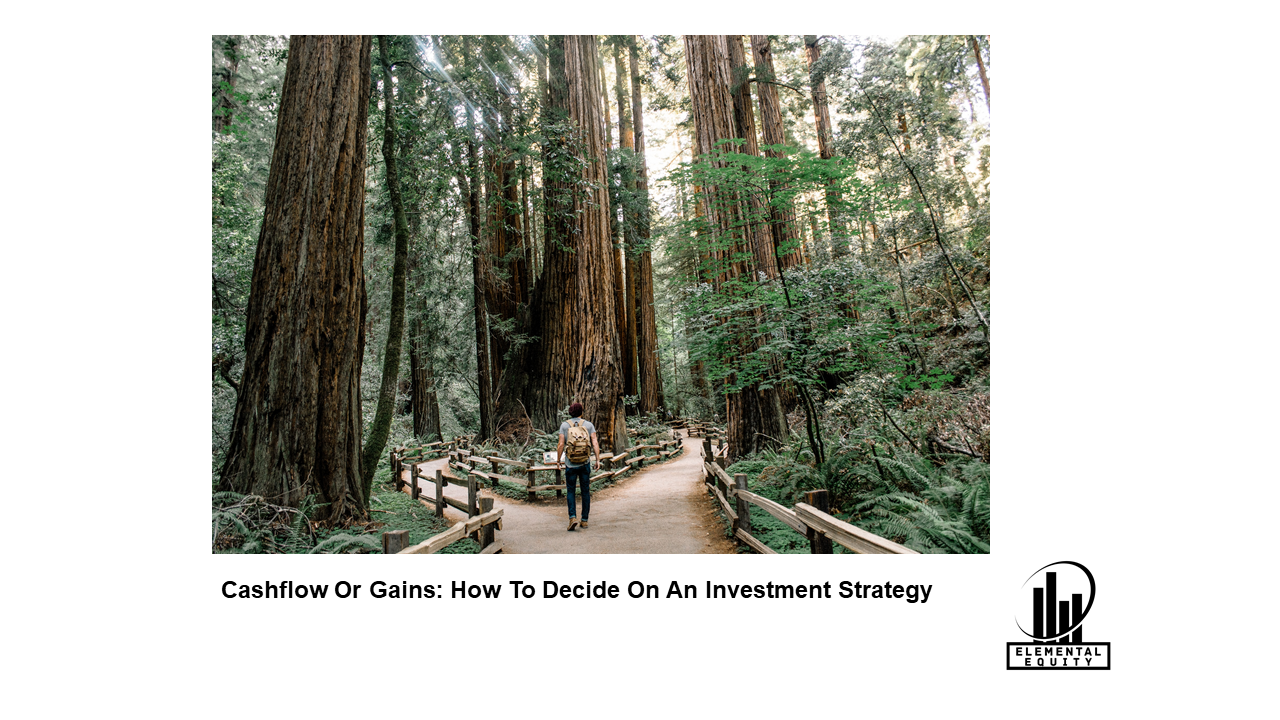Cashflow Or Gains: How To Decide On An Investment Strategy
At Elemental Equity, we believe in sharing our knowledge and expertise in multifamily real estate investing with you.

It happens to the best of us – we get caught
up in economic news, assumptions about where the market is going, and we can’t
help but wonder, “What’s the best investment strategy in today’s environment?”
Once you decide you’re going to invest in a
real estate syndication deal, and you hurdle questions about risk, rates of
return, and how real estate syndications work, your concern naturally pivots
toward what investment strategy is best.
You want to know what to look for, what is a
red flag, and what you should or shouldn’t do based on the current market cycle
and the most recent economic conditions. This year, this market, this climate
is different than any other, so your investing strategy should compensate,
right?
Well, the only constant in life is change. The
most important thing is that you know what the main two strategies are and why
each is important. From there, you can make an informed decision no matter what
the economy and the market are doing.
Two Investing Strategies
The two most common and most widely discussed,
overarching investment strategies are:
1)
Gains Strategy
2)
Cashflow Strategy
Both strategies are essential to the bigger
picture, and you’ve got to be informed about each one and how it might affect
your financial situation to strategize appropriately.
A gains-focused investment strategy is focused
on buying low and selling high, creating a gap of profit (gain) between the two
transactions. Some great examples of this in residential properties are
foreclosures and fix-and-flips. In real
estate syndication properties, the business plan will give you details in
alignment with buying undervalued property at a killer deal, executing light
renovations, and selling at a much higher market price. This may or may not be
a quick turnaround deal and the cashflow might be on the lighter side.
On the other hand, in cashflow-focused
strategies, you’d buy and hold for a long period of time with the expectation
of constant distributions month after month. Rental properties with existing,
faithful tenants like in large apartment complexes are great examples. There
might be some natural appreciation in the deal, but the most attractive quality
highlighted in the business plan is the predictable returns.
The Gains Plan
The caveat to pursuing gains only, is that you
have to know the asset’s actual value
and the market trajectory, almost guaranteeing you’re getting a great deal on
the buy.
In real estate, there’s a saying –
“You
make your money when you buy, not when you sell.”
It means that you can’t rely on what you think
the price should be, that you can’t rely on market appreciation, and that you
definitely shouldn’t be expecting renovations to make the deal profitable. In
other words, you must buy at a discount so
that you can sell for a profit.
The gains strategy also requires that you have
a separate income to support your lifestyle and the asset throughout the time
you own it. Assuming the property isn’t providing you any monthly income, you
still have your own bills, transportation, and food to pay for, including
mortgage, insurance, and any repairs that come up before you sell.
A narrow focus on investing for gains comes
with an inherent business risk since you must be prepared to hold and sustain
the asset through market dips, without any returns from the investment, until
you can sell for your desired gains.
One more thing, if your goal is to sell when
the property appreciates 20%, you have to be disciplined enough to sell right
then. Some investors get hung up when they decide to “just hold it another
year, ‘cause the market’s skyrocketing right now” but things crash six months
later.
The Cashflow Plan
Planning solely for cashflow is about
consistent monthly or quarterly distributions over the longterm. It’s not about
trying to time the market, buy low, or create a big spread. In an ideal
cash-flowing investment, there’s enough distributed each month to cover
property costs like the mortgage and insurance, plus renovations or repairs
needed, and still have some profit left.
On cash-flowing properties, you always have to
assess sustainability over the long term. Meaning, how sustainable is the
profit each month? If you’ve got $100 after the mortgage and insurance is paid,
awesome, and yes, the property is cash flowing. But what happens when you have
to replace the hot water heater for $800? That means for eight months you have
$0 in profit. So you have to assess if the profit made after expenses each
month is really sustainable and if the investment property will still be
profitable if you have a repair or two.
Another consideration is, for example, with
that same $100 in profit on a residential rental each month, what if the market
contracts and you have a hard time finding a tenant? Lowering rental rates to
fill the unit might make it so the property is no longer cash flowing. You have
to know ahead of time how you’ll handle that and decide the rate of cashflow
you require on a property, so ownership is sustainable long-term.
A caveat to an only cashflow-focused
investment plan can leave you blind to the long-term wealth-building potential
of appreciation, especially if the cashflow is funding your lifestyle instead
of being reinvested.
Why Not Both?
The good news is that the answer to the
question, “What’s the best investment strategy for me in today’s environment?”
is not binary. You can pick both!!
You can absolutely earn steady passive
cashflow AND enjoy the wealth-building power of appreciation by pursuing real
estate investment syndications featuring both benefits at the same time.
Don’t corner yourself into cash-flowing
properties that have little to no long-term expected appreciation.
AND
Don’t hamper your cashflow by investing in
properties that are only focused on gains.
Here at Elemental
Equity, we believe the best way to build wealth and freedom simultaneously
is to invest in real estate syndications with cashflow and appreciation built
into each deal.
Deciding Which Plan Is Best For
You Right Now
Ultimately your personal situation and your
investing goals will determine what features you prefer in an investment
opportunity. If you need $0 in cashflow now and are focused on building your
retirement account that you won’t touch for another 30 years, then aggressive
appreciation-focused (gains) deals might be your focus.
On the other hand, if cashflow would allow
your spouse to ditch the corporate stress and fulfill dreams of being more
present with the family, then a reliable, cashflow-focused syndication might
bring you joy.
Before you choose a particular strategy,
consider what might be in your life’s near and distant future and then explore
how investing in real estate syndications might support that vision. Ask
yourself about any significant shifts that might occur within the next five
years, like graduations, weddings, daycare, public schools, new cars, moves,
additional education, or career changes.
With a clear plan for where you’re going, it
will be much easier to determine which investment strategy is best for you.
Only then will you know to invest real estate syndication deals aligned with
the gains plan, the cashflow plan, or a mix of both.
Leave a comment
Contact
Notes:
- To be an accredited investor, you must EITHER have a net worth of $1M+ (not counting your primary home) OR have an annual income of $200K+ as an individual ($300K+ for joint income) over the last 2 years, with the expectation of the same income in the current year.
- A classification of investor indicating someone who has sufficient income ($100K+), capital (liquidity to invest), experience, education within the investment class, and net worth ($350K+) to engage in more advanced types of investment opportunities.


